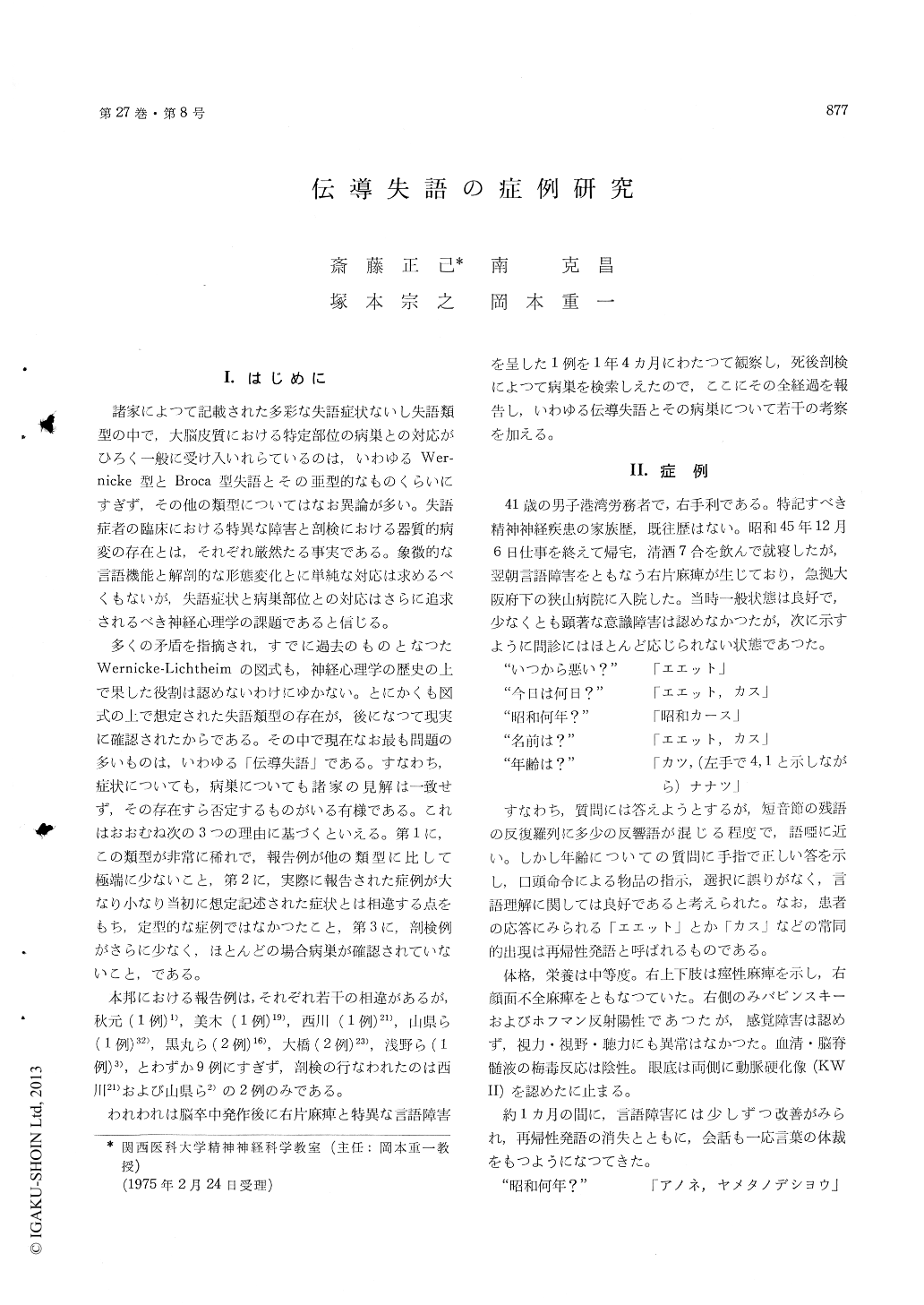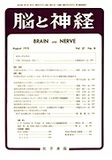Japanese
English
- 有料閲覧
- Abstract 文献概要
- 1ページ目 Look Inside
I.はじめに
諸家によつて記載された多彩な失語症状ないし失語類型の中で,大脳皮質における特定部位の病巣との対応がひろく一般に受け入いれらているのは,いわゆるWer—nicke型とBroca型失語とその亜型的なものくらいにすぎず,その他の類型についてはなお異論が多い。失語症者の臨床における特異な障害と剖検における器質的病変の存在とは,それぞれ厳然たる事実である。象徴的な言語機能と解剖的な形態変化とに単純な対応は求めるべくもないが,失語症状と病巣部位との対応はさらに追求されるべき神経心理学の課題であると信じる。
多くの矛盾を指摘され,すでに過去のものとなつたWernicke-Lichtheimの図式も,神経心理学の歴史の上で果した役割は認めないわけにゆかない。とにかくも図式の上で想定された失語類型の存在が,後になつて現実に確認されたからである。その中で現在なお最も問題の多いものは,いわゆる「伝導失語」である。すなわち,症状についても,病巣についても諸家の見解は一致せず,その存在すら否定するものがいる有様である。これはおおむね次の3つの理由に基づくといえる。第1に,この類型が非常に稀れで,報告例が他の類型に比して極端に少ないこと,第2に,実際に報告された症例が大なり小なり当初に想定記述された症状とは相違する点をもち,定型的な症例ではなかつたこと,第3に,剖検例がさらに少なく,ほとんどの場合病巣が確認されていないこと,である。
The authors have studied a 41 years old right-handed male patient, who developed typical features of conduction aphasia after cerebral apoplexy, clinically over one year and anatomically after his desease for acute purulent mediastinitis.
The results are as follows :
1) After disappearence of transient disorders of verbal expression in acute stage, the patient pre-sented a pure form of conduction aphasia lasting for a longer period of time while he had never shown any disturbance of verbal reception and understanding. Thus, the authors has been con-vinced of that the conduction aphasia is not a sub-type or a temporary feature in convalescence of sensory aphasia.
2) Paraphasia and disturbance of repetition were the only and main symptoms in oral speech, but the latter was less predominant than the former. Word amnesia and grammatical disturbance have never been found. In written language, paralexia and paragraphia were persistently manifested throughout the course.
3) Literal paraphasia was much more frequent than varbal paraphasia both in spoken and in written languages. It was also noted that the paraphasia was considerably influenced by patient's attitude and reaction to his situation and circumst-ance.
4) As to repetition of sounds, words or phrases, the longer the syllables the more the disturbances, of which the features mainly consisted of para-phasia and partial omission and the incidences varied in accordance with the differences of tones and meanings of the given words, in contrast to the disorders of secondary articulation.
5) Any other agnosic or apraxic disability was not revealed by the systemic neuropsychologicalexaminations.
6) Based on the findings, it can be said that the conduction aphasia is exclusively due to an im-pairment of inner speech process, particularly that of expressive programming rather than otherwise.
7) In autopsy, it was confirmed that the lesion in left Insula Reili involved the entire medulla but neither its cortex nor the adjacent areas in the temporal and parietal lobes. Hence, the medullar lesion of the left insula must be responsible while its cortical and other lesions are not indispensable so far as the pure form of conduction aphasia is concerned.

Copyright © 1975, Igaku-Shoin Ltd. All rights reserved.


